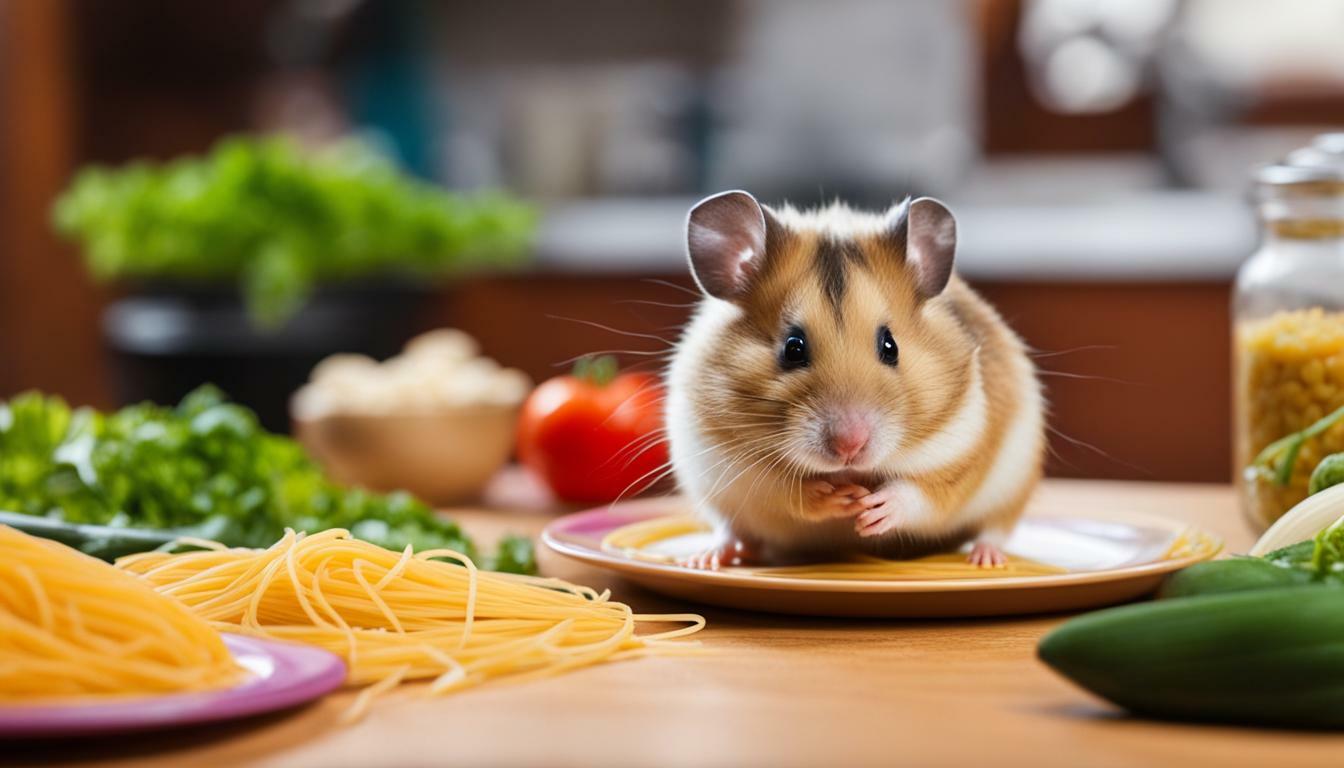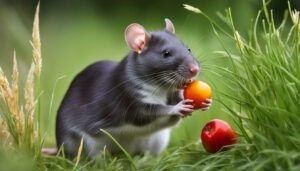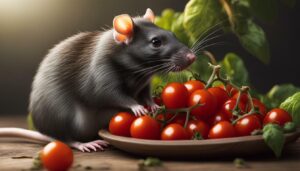If you’re wondering whether your furry friend can enjoy a plate of spaghetti, we’ve got all the answers for you.
Key Takeaways:
- Hamsters can eat spaghetti, both raw and cooked, but it should be given in moderation due to its high carbohydrate content.
- Avoid adding butter or salt to the pasta when feeding it to your hamster.
- White pasta may stick to a hamster’s teeth, so it’s important to monitor their oral health.
- Dried pasta with added vitamins and minerals can be a healthier option for hamsters.
- Different breeds of hamsters, including Syrian, Roborovski, Campbell, Djungarian, and Chinese, can all enjoy pasta as a treat, but it should not make up a significant portion of their diet.
The Dietary Needs of Hamsters
Before we delve into the specifics of spaghetti, it’s crucial to understand the dietary needs of hamsters and how to keep them healthy. Hamsters are omnivores, meaning they require a balanced diet consisting of both plant-based and animal-based foods. Providing the right nutrition is essential for their overall well-being and longevity.
The primary component of a hamster’s diet should be a high-quality commercial hamster food. These specially formulated pellets contain a blend of grains, seeds, and pellets that are nutritionally balanced to meet the needs of hamsters. It’s important to choose a brand that is specifically designed for hamsters, as they have different dietary requirements compared to other small pets.
In addition to their commercial food, it is crucial to supplement your hamster’s diet with fresh fruits and vegetables. These can include small portions of leafy greens, carrots, cucumbers, and broccoli. Fruits like apples, bananas, and strawberries can be given as occasional treats as they are high in natural sugars. It’s important to remember to wash all fruits and vegetables thoroughly before offering them to your hamster.
| Safe Foods for Hamsters | Foods to Avoid |
|---|---|
|
|
It’s important to note that while hamsters can eat spaghetti, it should only be given as an occasional treat. Spaghetti is high in carbohydrates, so it’s important to feed it in moderation. Make sure to cook the pasta without any added butter or salt, as these can be harmful to your hamster. Additionally, white pasta may stick to a hamster’s teeth, so it’s recommended to opt for whole wheat or multigrain pasta instead.
Nutritional Benefits of Dried Pasta
In addition to cooked spaghetti, you can also offer dried pasta to your hamster. Dried pasta is a healthier option as it often contains added vitamins and minerals. It’s important to choose plain dried pasta without any added flavorings or seasonings. This can serve as a crunchy treat that satisfies your hamster’s natural chewing instincts while providing some additional nutrients.
Remember, moderation is key when it comes to treating your hamster with spaghetti or dried pasta. While it can be an occasional addition to their diet, it should not make up a large portion of their daily food intake. Always monitor your hamster’s overall consumption and consult with a veterinarian if you have any concerns about their diet or health.
What Can Hamsters Eat?
Hamsters can enjoy a wide variety of foods, but not everything is suitable for their digestive system. It’s important to provide them with a well-balanced diet that meets their nutritional needs. The key is to offer a mix of fresh fruits and vegetables, high-quality pellets or hamster food, and occasional treats.
Safe Fruits and Vegetables for Hamsters
| Fruits | Vegetables |
|---|---|
| Apples | Carrots |
| Bananas | Cucumbers |
| Strawberries | Parsley |
- Avoid feeding your hamster citrus fruits or grapes, as they can be too acidic for their stomach.
- Always wash fruits and vegetables thoroughly before offering them to your furry friend.
- Introduce new foods gradually to avoid digestive upset.
- Ensure the portions are small and easy for your hamster to handle.
Hamster Food Recommendations
In addition to fresh produce, you should provide your hamster with a good quality pellet or hamster food. Look for brands that contain a mix of seeds, grains, and dried vegetables. Avoid food mixes that are high in sugar, as they can lead to obesity and other health issues.
“I always make sure to provide my hamster with a mix of fruits, vegetables, and pellets to keep him healthy and happy!” – Hamster Owner
Treats for Hamsters
While it’s important to offer treats in moderation, they can be a fun way to bond with your hamster. Some suitable treat options include small pieces of cooked chicken, mealworms, and plain, unsweetened yogurt. Avoid giving your hamster sugary or salty snacks, as they can be harmful to their health.
Remember, every hamster is unique, and their dietary preferences may vary. It’s always a good idea to consult with a veterinarian or do thorough research to ensure you’re providing the best diet for your furry friend. By offering a varied and nutritious diet, you can help keep your hamster healthy and happy for years to come!
Hamsters and Spaghetti
Now, let’s address the burning question – can hamsters indulge in a plate of spaghetti? The good news is that hamsters can indeed eat spaghetti, both raw and cooked. However, it’s important to remember that moderation is key. Spaghetti is high in carbohydrates, so it should only be given to your furry friend as an occasional treat rather than a staple in their diet.
When serving spaghetti to your hamster, it’s crucial to avoid adding any butter or salt to the pasta. These additional ingredients can be harmful to their tiny bodies. Additionally, be mindful of the type of pasta you choose to offer. White pasta may stick to a hamster’s teeth, causing potential dental issues. So, it’s recommended to opt for whole wheat or grain-based pasta, which is easier for them to chew and digest.
Remember, moderation is key when it comes to feeding hamsters spaghetti. While they can enjoy this tasty treat, it should not make up a large portion of their diet. Instead, focus on providing a well-balanced mix of other safe foods that meet their nutritional needs.
If you’re looking for a healthier alternative, consider offering your hamster dried pasta. Dried pasta is often enriched with vitamins and minerals, making it a more nutritious choice. However, just like with regular pasta, it should only be given in small amounts to prevent weight gain.
| Pasta Type | Serving Size | Frequency |
|---|---|---|
| Raw or Cooked Spaghetti | A few small pieces | Occasional treat |
| Dried Pasta | A small piece or two | Occasional treat |
As with any food, it’s essential to observe your hamster’s reaction to spaghetti. If you notice any signs of digestive discomfort or changes in their behavior, it’s best to avoid feeding them pasta altogether. Remember, a varied and balanced diet is crucial to keep your hamster healthy and happy.
Raw or Cooked Spaghetti?
Whether you prefer your spaghetti raw or cooked, you might be wondering which option is best for your hamster. The good news is that hamsters can safely eat both raw and cooked spaghetti. However, there are a few factors to consider when deciding how to serve this pasta treat to your furry friend.
If you choose to feed your hamster raw spaghetti, make sure it is dry and unseasoned. Raw spaghetti can be a fun and crunchy snack for your hamster, providing them with a bit of variety in their diet. Just be aware that raw pasta can be harder for hamsters to chew, so it’s important to monitor their eating habits and ensure they are not struggling to consume it.
On the other hand, cooked spaghetti is a softer option that may be easier for your hamster to chew and digest. When cooking spaghetti for your hamster, be sure to cook it plain without adding any butter or salt. These additions can be harmful to hamsters and should be avoided. Additionally, keep in mind that white pasta may stick to a hamster’s teeth, so it’s best to opt for whole wheat or grain-based pasta options.
| Raw or Cooked Spaghetti Recommendations | |
|---|---|
| Raw Spaghetti | – Dry and unseasoned – Crunchy snack, but monitor chewing – Provide variety in diet |
| Cooked Spaghetti | – Plain and unseasoned – Softer texture, easier to chew and digest – Choose whole wheat or grain-based pasta |
Remember, spaghetti should only be given to hamsters as an occasional treat and not as a significant portion of their diet. While hamsters can enjoy pasta, it is important to prioritize their nutritional needs and provide a balanced diet consisting of hamster-specific pellets, fresh fruits, vegetables, and occasional treats like spaghetti. By offering a varied and nutritious diet, you can ensure that your hamster stays healthy and happy!
Spaghetti and Hamster Teeth
While spaghetti itself may be safe for hamsters to consume, there are concerns regarding its impact on their teeth. Hamsters’ teeth continuously grow, and they need to chew on hard materials to wear them down and prevent overgrowth. The texture of spaghetti, especially cooked and soft spaghetti, may not provide sufficient resistance for this purpose. As a result, there is a risk of the pasta sticking to their teeth and causing potential dental issues.
It is important to note that different breeds of hamsters may have different levels of susceptibility to dental problems. For example, Syrian hamsters have larger teeth and a stronger bite force, making them less prone to dental issues compared to other smaller breeds like Roborovski or Campbell hamsters. However, all hamsters should be monitored for any signs of dental problems when consuming spaghetti or other sticky foods.
To minimize the risk of dental issues, it is recommended to provide a variety of chew toys and treats specifically designed for hamsters. These toys are usually made of safe materials, such as wood or hard plastic, and can help keep their teeth in good condition. Additionally, offering a balanced diet that includes a variety of vegetables, fruits, and specially formulated hamster pellets will ensure that they receive the necessary nutrients for overall dental health.
| Hamster Breed | Dietary Recommendations |
|---|---|
| Syrian | Monitor dental health but can enjoy small amounts of spaghetti as a treat. |
| Roborovski | May be more prone to dental problems; limit spaghetti consumption and focus on chew toys for dental maintenance. |
| Campbell | Monitor dental health and provide alternative chew toys for dental care. |
| Djungarian | Monitor dental health and offer chew toys to prevent issues. |
| Chinese | Keep a close eye on dental health and provide appropriate chew toys. |
Remember, moderation is key when it comes to feeding hamsters spaghetti. While it can be a tasty treat for them, spaghetti should not make up a substantial portion of their diet. By providing a well-rounded and balanced diet, monitoring dental health, and offering dental enrichment, you can help ensure that your hamster remains happy and healthy.
Dried Pasta for Hamsters
If you want to offer your hamster a healthier version of pasta, dried pasta might be the way to go. Dried pasta is made from durum wheat semolina and doesn’t contain any added salt or butter, making it a suitable option for your hamster’s diet. It also has the benefit of being more nutritious than regular pasta, as it often contains added vitamins and minerals that can support your pet’s overall health.
When feeding your hamster dried pasta, it’s important to remember that moderation is key. While pasta can be a tasty treat for your furry friend, it shouldn’t make up a large portion of their diet. Instead, consider it as an occasional snack to provide some variety in their meals. Offering a small amount of dried pasta once or twice a week alongside their regular hamster food will help keep their diet balanced and prevent overindulgence.
It’s worth noting that different breeds of hamsters, such as Syrian, Roborovski, Campbell, Djungarian, and Chinese, can all enjoy the occasional serving of pasta. However, always introduce new foods gradually and monitor your hamster’s reaction to ensure they tolerate it well. If you notice any digestive issues or changes in their behavior, it’s best to consult with a veterinarian.
Hamster-Friendly Pasta Options
When choosing dried pasta for your hamster, opt for small shapes that are easy to eat and won’t pose a choking hazard. Look for pasta with a short cooking time, as this will ensure it remains firm and doesn’t become too soft or sticky.
| Pasta Shape | Example |
|---|---|
| Elbow macaroni | “Elbow macaroni is a great option for your hamster due to its small size and quick cooking time. It’s easy for them to nibble on and provides a fun texture for them to explore.” |
| Rotini | “Rotini pasta’s spiral shape adds a bit of excitement to your hamster’s mealtime. Just make sure it’s cooked al dente to prevent it from becoming too soft.” |
| Penne | “Penne pasta is another suitable choice for your hamster’s dried pasta treats. Its small tube shape allows for easy munching.” |
Remember, always cook dried pasta according to the package instructions, and let it cool completely before offering it to your hamster. This will ensure their safety and enjoyment as they munch on their pasta treat!
Moderation and Portion Control
Just like with any food, it’s crucial to ensure that spaghetti is given to hamsters in appropriate amounts. While hamsters can eat spaghetti, it should only be offered as an occasional treat rather than a staple in their diet. Spaghetti is high in carbohydrates, so feeding too much can lead to weight gain and other health issues.
It’s best to offer small portions of cooked spaghetti without any added butter or salt. These additions can be harmful to hamsters and should be avoided. Additionally, white pasta may stick to a hamster’s teeth, so it’s important to monitor their dental health when feeding them spaghetti. If you notice any issues, such as difficulty eating or unusual behavior, consult a veterinarian.
An alternative to cooked spaghetti is dried pasta, which can be a healthier option for hamsters. Dried pasta specifically made for small pets often contains added vitamins and minerals, providing additional nutritional benefits. However, it’s still important to offer dried pasta in moderation and alongside a balanced diet that includes other hamster-friendly foods.
To ensure your hamster’s overall health and well-being, consider consulting with a veterinarian or a qualified pet nutritionist. They can provide personalized guidance on your hamster’s specific dietary needs and help you create a suitable meal plan. Remember, a varied and balanced diet is essential for your furry friend’s optimal health.
| Key Points: |
|---|
| – Spaghetti should be given to hamsters as an occasional treat. |
| – Avoid adding butter or salt to the pasta. |
| – White pasta may stick to a hamster’s teeth, so monitor dental health. |
| – Dried pasta for small pets can be a healthier option. |
| – Consult a veterinarian for personalized dietary advice. |
Suitable Pasta for Hamsters
Not all pasta is created equal, and some varieties are more suitable for hamsters than others. When choosing pasta for your furry friend, it’s important to opt for types that are safe and nutritious. Whole wheat and durum wheat pasta are excellent choices as they are high in fiber and provide essential nutrients. These varieties are less processed and contain more vitamins and minerals compared to regular white pasta.
“Hamsters can eat spaghetti, both raw and cooked.”
When feeding pasta to your hamster, it’s crucial to avoid adding any butter or salt. These additives can be harmful to your pet’s health and should be strictly avoided. Additionally, white pasta may stick to a hamster’s teeth, potentially causing dental issues. To prevent this, it’s recommended to cook the pasta until it is soft and easy for your hamster to chew.
| Pasta Variety | Suitability for Hamsters |
|---|---|
| Whole wheat pasta | Highly suitable; rich in fiber and nutrients |
| Durum wheat pasta | Recommended; contains essential vitamins and minerals |
| White pasta | Use sparingly; may stick to hamster’s teeth |
“Hamsters can also eat dried pasta, which is healthier as it contains added vitamins and minerals.”
In addition to cooked pasta, you can offer your hamster dried pasta as a treat. Dried pasta is a better option as it often contains added vitamins and minerals, providing an extra nutritional boost for your pet. Remember to offer pasta in small amounts as an occasional treat, rather than a staple in their diet. Variety is key in a hamster’s nutrition, so ensure they also have a well-balanced diet composed of pellets, fruits, vegetables, and occasional protein-rich treats.
By selecting suitable pasta options and incorporating them into your hamster’s diet in moderation, you can provide a tasty and nutritious treat for your furry companion.
Hamster Treats and Alternatives to Spaghetti
While spaghetti can be a treat for your hamster, it’s essential to provide them with a diverse range of foods. A healthy hamster diet should include a variety of fresh fruits, vegetables, and high-quality hamster pellets. These options not only offer a balanced nutrition but also help to promote their overall well-being.
When treating your hamster, it’s important to remember portion control. Too many treats, including spaghetti, can lead to weight gain and potential health issues. Instead of relying solely on pasta as a treat, consider offering other alternatives that are safe and nutritious for your furry friend.
Here are some hamster-friendly treats and alternatives to spaghetti:
- Small pieces of fresh fruits such as apple, pear, or banana
- Vegetables like carrot, broccoli, or cucumber
- Occasional small amounts of cooked chicken or scrambled eggs
- Hamster-safe seeds and nuts, such as sunflower or pumpkin seeds
Remember to introduce new foods gradually and observe your hamster for any signs of allergies or digestive issues. If your hamster has any pre-existing health conditions, it’s best to consult with a veterinarian for specific dietary recommendations.
By offering a varied and nutritious diet, you can ensure that your hamster stays healthy, happy, and satisfied. Treats like spaghetti can be included occasionally, but always in moderation. Remember to prioritize their overall diet and provide them with a well-balanced meal plan.
| Treat | Description |
|---|---|
| Small pieces of fresh fruits | Provides natural sugars and vitamins for your hamster |
| Vegetables | Offers essential nutrients and adds variety to their diet |
| Cooked chicken or scrambled eggs | Provides high-quality protein as an occasional treat |
| Hamster-safe seeds and nuts | Offers healthy fats and essential nutrients for their diet |
Conclusion
After considering all the factors and information, it’s clear that hamsters can enjoy spaghetti in moderation as part of a balanced diet. Hamsters can safely consume both raw and cooked spaghetti, but it should be given in small amounts due to its high carbohydrate content. It’s important to avoid adding butter or salt to the pasta, as these can be harmful to hamsters.
While hamsters can eat spaghetti, it’s worth noting that white pasta may stick to their teeth. This can potentially lead to dental issues, so it’s important to monitor their dental health and provide appropriate measures if necessary. Additionally, different breeds of hamsters, such as Syrian, Roborovski, Campbell, Djungarian, and Chinese, can all enjoy pasta, but it should only be given as an occasional treat and not as a significant portion of their diet.
If you’re considering feeding your hamster pasta, dried pasta is a healthier option as it often contains added vitamins and minerals. This can provide some nutritional benefits to your furry friend. However, as with any food, moderation and portion control are key. It’s important to remember that hamsters require a varied and balanced diet, so pasta should not be the sole focus of their meals.
In conclusion, while hamsters can eat spaghetti, it’s essential to approach their diet with care. Offering spaghetti as an occasional treat can provide some enjoyment for your hamster, but make sure to prioritize their overall nutritional needs. By incorporating a variety of safe and suitable foods into their diet, you can ensure that your hamster stays healthy and happy.
FAQ
Can hamsters eat spaghetti?
Yes, hamsters can eat spaghetti, both raw and cooked. However, it should be given in moderation as it is high in carbohydrates.
What should I avoid adding to the pasta for my hamster?
It is important to avoid adding butter or salt to the pasta, as these can be harmful to hamsters.
Will white pasta stick to a hamster’s teeth?
Yes, white pasta may stick to a hamster’s teeth, so it is worth noting and taking precautions to prevent dental issues.
Can different breeds of hamsters eat pasta?
Yes, different breeds of hamsters, such as Syrian, Roborovski, Campbell, Djungarian, and Chinese, can all eat pasta. However, it should still be given in small amounts.
Can hamsters eat dried pasta?
Yes, hamsters can eat dried pasta, which is healthier as it contains added vitamins and minerals.
How much pasta should I give to my hamster?
Pasta should be given in moderation as a treat and should not make up a large portion of a hamster’s diet. Portion control is important.
What types of pasta are safe for hamsters?
The types of pasta that are safe for hamsters to consume include plain spaghetti, macaroni, and other small pasta shapes.
Are there alternative treats for hamsters?
Yes, there are alternative treat options for hamsters, such as fresh fruits and vegetables, healthy seeds, and specially formulated hamster treats available in pet stores.




